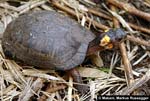Glyptemys muhlenbergii, the bog turtle,  is a member of the largest and most diverse group of turtles, Emydidae. Until recently, G. muhlenbergii was included in the genus Clemmys, along with Clemmys insculpta (the wood turtle, now Glyptemys insculpta) and Clemmys guttata (the spotted turtle). It was found, however, that the wood turtle and bog turtle remained each other’s closest relatives. However, neither taxon was closely related to the spotted turtle, and overall, the genus Clemmys was paraphyletic when these two turtles were included (Bickham, et al., 1996; Burke et al., 1996; Gaffney and Meylan, 1988). Subsequently, these taxa were removed from Clemmys and placed in their own genus, Glyptemys, as recommended by Holman and Fritz (2001).
is a member of the largest and most diverse group of turtles, Emydidae. Until recently, G. muhlenbergii was included in the genus Clemmys, along with Clemmys insculpta (the wood turtle, now Glyptemys insculpta) and Clemmys guttata (the spotted turtle). It was found, however, that the wood turtle and bog turtle remained each other’s closest relatives. However, neither taxon was closely related to the spotted turtle, and overall, the genus Clemmys was paraphyletic when these two turtles were included (Bickham, et al., 1996; Burke et al., 1996; Gaffney and Meylan, 1988). Subsequently, these taxa were removed from Clemmys and placed in their own genus, Glyptemys, as recommended by Holman and Fritz (2001).
Glyptemys muhlenbergii exhibits a small, testudinid-like skull, with a widely emarginated temporal region and lack of a squamosal-parietal contact characteristic of most emydids (Ernst and Barbour, 1989). Additionally, emydids tend to have well-developed dorsal rib heads, an unjoined maxilla and quadratojugal, a reduction of the femoral trochanteric fossa, and an absence of mesoplastral, intergular, and inframarginal scutes (Ernst and Barbour, 1989). Characters that are diagnostic for the bog turtle include a weakly keeled carapace, a medially notched maxilla, and vertebral scutes that are longer rather than wider (5th is longest) (Ernst and Barbour, 1989).
Emydidae is known for its large abundance of semi-aquatic 'pond turtles', and the bog turtle certainly fits that description. This species can be found living in swamps, bogs, fens, and the slow moving-streams of marshy meadows in the eastern United States. However, one should not expect to come across this species as often as its hugely abundant relatives, Chrysemys, because G. muhlenbergii is considered by many to be the rarest turtles in North America. Its range, though spanning from New York to western Massachusetts and south to northern Georgia and eastern Tennessee, is highly fragmented and discontinuous (ADW: Harding 2002). Most colonies are small, and individuals rarely migrate out of a 0.1 to 3.1 hectare home range (ADW: Harding 2002). It may come as no surprise that bog turtles are endangered and that the main threat comes from the destruction of its already tiny and fragile habitat
Another major threat to G. muhlenbergii is the illegal capture for private and commercial purposes. Bog turtles are actually the smallest species of turtle in North America, with an adult size hardly ever exceeding 11.5 cm (4.5 in) (Ernst and Barbour 1989), and this no doubt, only adds to their appeal. This species is also known for its mild-mannered behavior, choosing to burrow when alarmed rather than bite or scratch, making it a popular target of the pet trade.

Literature
Bickham, J. W., and J. L. Carr. 1983. Taxonomy and phylogeny of the higher categories of cryptodiran turtles based on a cladistic analysis of chromosomal data. Copeia 1983:918-932.
Bickham, J., T. Lamb, P. Minx, J. Patton. 1996. Molecular systematics of the genus *Clemmys* and the intergeneric relationships of emydid turtles. Herpetologica 52: 89-97.
Brenner, D., G. Lewbart, M. Stebbins, and D. W. Herman. 2002. Health survey of wild and captive bog turtles (Clemmys muhlenbergii) in North Carolina and Virginia. Journal of Zoo and Wildlife Medicine 33:311-316.
Burke, R., T. Leuteritz, A. Wolf. 1996. Phylogenetic relationships of emydine turtles. Herpetologica 52: 572-584.
Chase, J., K. Dixon, J. Gates, D. Jacobs, and G. Taylor. 1989. Habitat characteristics, population size, and home range of the Bog Turtle (Clemmys muhlenbergii) in Maryland. Journal of Herpetology 23:356-362.
Fahey, K.M. 1999. Geographic Distribution. Clemmys muhlenbergii. Herpetological Review 30:108.
Ernst, C. H., and W. Barbour. 1989. Turtles of the World. Smithsonian Institution Press, Washington, D. C., 311 pp.
Gaffney, E. S. 1979. Comparative cranial morphology of Recent and fossil turtles. Bulletin of the American Museum of Natural History 164:67-376
Holman and Fritz. 2001. Zoologische Abhandlungen Staatliches Museum für Tierkunde Dresden 51:331-353.
Lovich, J. E., C. H. Ernst, R. T. Zappalorti, and D. W. Herman. 1998. Geographic variation in growth and sexual size dimorphism of bog turtles (Clemmys muhlenbergii). American Midland Naturalist 139:69-78.
Morrow, J.L., J.H. Howard, S.A. Smith, and D.K. Poppel. 2001. Habitat Selection and Habitat Use by the Bog Turtle (Clemmys muhlenbergii) in Maryland. Journal of Herpetology 35:545-552.
Shaffer, H. B., P. Meylan, and M. L. McKnight. 1997. Tests of turtle phylogeny: molecular, morphological, and paleontological approaches. Systematic Biology 46:235-268.
Stephens, P. R., and J. J. Wiens. 2003. Ecological diversification and phylogeny of emydid turtles. Biologidal Journal of the Linnean Society 79:577-610.
Links
Harding's (2002) information on Glyptemys muhlenbergi on the Animal Diversity Web (ADW) (Univ. of Michigan Museum of Zoology)
The research website of Dr. Eugene Gaffney of the American Museum of Natural History


